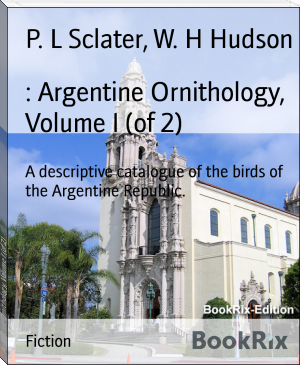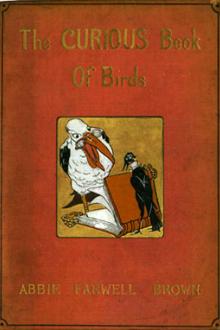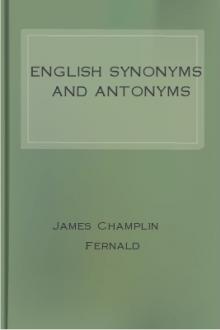: Argentine Ornithology, Volume I (of 2), P. L Sclater, W. H Hudson [best authors to read txt] 📗

- Author: P. L Sclater, W. H Hudson
Book online «: Argentine Ornithology, Volume I (of 2), P. L Sclater, W. H Hudson [best authors to read txt] 📗». Author P. L Sclater, W. H Hudson
olivaceous brown above, and much paler beneath; lores and upper part
of throat pure white, lower part of throat black, or white and black
mixed; under wing-coverts white, faintly tinged with pale cinnamon;
beak and feet bluish grey: whole length 9·4 inches, wing 4·0, tail
3·2. _Female_ similar.
_Hab._ Patagonia.
I found this bird quite common on the dry open plains in the
neighbourhood of the Rio Negro in Patagonia. In size, form, and crest
it is like the northern Cachalote, but has a white throat, while the
rest of the plumage is of a pale earthy brown instead of rufous. Like
the Brown Cachalote it is also shy in disposition, and, being so dull
in colour and without the bright beak and eye tints, has not the
bold, striking appearance of that species; still I do not think any
ornithologist can meet with it and fail to be strongly impressed with
its personality, if such a word can be applied to a bird.
Dendrocolaptine birds are, as a rule, builders of big nests and very
noisy; _H. gutturalis_ is, I believe, the loudest screamer and greatest
builder of the family. Male and female live together in the same
locality all the year; the young, when able to fly, remain with
their parents till the breeding-season, so that the birds are found
occasionally in pairs, but more frequently in families of five or six
individuals. When feeding they scatter about, each bird attaching itself
to a large bush, scraping and prodding for insects about the roots; and
at intervals one of the old birds, ascending a bush, summons the others
with loud shrill cries, on which they all hurry to the place of meeting,
and from the summits of the bushes burst forth in a piercing chorus,
which sounds at a distance like screams of hysterical laughter. At one
place, where I spent some months, there were some bushes over a mile
and a quarter from the house I lived in, where these birds used to hold
frequent meetings, and in that still atmosphere I could distinctly hear
their extravagant cries at this distance. After each performance they
pursue each other, passing from bush to bush with a wild jerky flight,
and uttering harsh angry notes.
They select a low, strong, wide-spreading bush to build in; the nest,
which is made of stout sticks, is perfectly spherical and four to five
feet deep, the chamber inside being very large. The opening is at the
side near the top, and is approached by a narrow arched gallery, neatly
made of slender sticks resting along a horizontal branch, and about
fourteen inches long. This peculiar entrance, no doubt, prevents the
intrusion of snakes and small mammals. So strongly made is the nest that
I have stood on the dome of one and stamped on it with my foot without
injuring it in the least, and to demolish one I had to force my
gun-barrel into it, then prize it up by portions. I examined about a
dozen of these enormous structures, but they were all met with before
or after the laying season, so that I did not see the eggs.
ANABAZENOPS OLEAGINEUS, Scl.
(OILY-GREEN ANABAZENOPS.)
+Anabazenops rufo-superciliatus+, _White, P. Z. S._ 1882, p. 613
(Catamarca). +Anabazenops oleagineus+, _Scl. P. Z. S._ 1883, p.
654.
_Description._--Above and beneath dark olive-green; lores,
superciliaries, and spots on the sides of the head yellowish white;
wings blackish, the outer webs of the feathers olive-brown; tail
bright chestnut; throat whitish yellow, on the lower part the yellow
feathers tipped with olive; breast and belly spotted with same
colour as the throat; bend of wing, under wing-coverts, and margins
of inner webs of secondaries fulvous yellow; bill and feet blackish:
whole length 6·2 inches, wing 3·2, tail 3·0. _Female_ similar.
_Hab._ South Brazil and Argentina.
White obtained examples of this species on the Sierra of Totoral. He
says it is a very wild bird and exceedingly scarce.
SITTOSOMUS ERITHACUS (Licht.).
(ROBIN-LIKE WOOD-HEWER.)
+Sittosomus olivaceus+, _White, P. Z. S._ 1882, p. 613 (Salta).
+Sittasomus erithacus+, _Scl. et Salv. Nomencl._ p. 66.
_Description._--Above olive-green, tinged with chestnut on the back,
rump, and upper wing-coverts; wings black, the basal part of the
inner webs of the secondaries fulvous yellow, forming a well-marked
transverse bar; outer webs and broad tips of inner secondaries and
whole of outer secondaries chestnut; tail and upper tail-coverts
chestnut; beneath yellowish olive, brighter on the throat and
breast; under wing-coverts fulvous yellow; under tail-coverts pale
chestnut; bill and feet black: whole length 6·2 inches, wing 3·0,
tail 3·0. _Female_ similar.
_Hab._ South America from Colombia to Northern Argentina.
This is a straggler from the north, a specimen of which was obtained by
White near Oran in 1880.
GLYPHORHYNCHUS CUNEATUS (Licht.).
(WEDGE-BILLED WOOD-HEWER.)
+Glyphorhynchus cuneatus+, _Scl. et Salv. Nomencl._ p. 67; _White, P.
S._ 1882, p. 613 (Misiones).
_Description._--Above olive-brown, superciliaries and small spots on
the side of the head yellowish white, rump and upper tail-coverts
chestnut; wings blackish, outer webs of wing-feathers olive-brown,
basal part of inner webs of secondaries yellowish white, forming a
transverse bar; tail chestnut; beneath earthy olive-brown, whitish
yellow on the throat, and with spots of the same colour on the
upper part of the breast; under wing-coverts white; bill and feet
horn-colour: whole length 5·1 inches, wing 2·5, tail 2·4. _Female_
similar.
_Hab._ South America from Colombia to Northern Argentina.
This is another northern form of which White obtained specimens in
Misiones. He says it is not uncommon there in the thick woods, also in
the orange-groves about the Jesuit ruins of St. Javier.
DENDROCOLAPTES PICUMNUS (Licht.).
(FLAT-BILLED WOOD-HEWER.)
+Dendrocolaptes picumnus+, _Scl. et Salv. Nomencl._ p. 67; _White, P.
S._ 1882, p. 613 (Misiones).
_Description._--Above olivaceous brown; head blackish, thickly
covered with yellowish-buff elongated shaft-spots; rump and upper
tail-coverts tinged with chestnut; wing-feathers chestnut, tinged
with olivaceous; tail chestnut; beneath pale earthy olive-brown,
paler on the throat, the shafts of the feathers of the breast buffy
white, forming long lines, the feathers of the belly and under
tail-coverts transversely barred with blackish; under wing-coverts
yellowish white, spotted with blackish; bill and feet black: whole
length 10·5 inches, wing 4·7, tail 4·6. _Female_ similar.
_Hab._ Brazil and Northern Argentina.
White obtained specimens of this species at Concepcion, "in the thickest
parts of the woods, near the river, climbing up the trees, around which
it turned in corkscrew fashion."
218. DRYMORNIS BRIDGESI, Eyton. (BRIDGES'S WOOD-HEWER.) [Plate X.]
+Drymornis bridgesi+, _Scl. et Salv. Nomencl._ p. 67; _White, P.
S._ 1882, p. 613 (Catamarca); _Barrows, Auk_, 1884, p. 20(Entrerios). +Nasica gracilirostris+, _Burm. La-Plata Reise_, ii.
466 (Rio Quinto).
_Description._--Above and below brown, brightest on the rump, and
palest beneath; long superciliaries extending down the neck, and
a mystacal stripe formed of white spots with faint black edgings;
wing-feathers blackish; tail chestnut; on the throat a broad white
band extending to the breast; breast and belly marked with large
oblong white spots, which are margined with narrow black edgings;
under wing-coverts and inner margins of secondaries bright cinnamon;
bill and feet horn-colour: whole length 12·10 inches, wing 5·6, tail
4·6. _Female_ similar.
_Hab._ North and West Argentina.
Eyton, when he described this species from Bridges's specimens, gave its
habitat as Bolivia. It may inhabit the southern part of that Republic,
but it is more probable that Bridges's examples were obtained in
Northern Argentina, which he likewise visited. Bridges's Wood-hewer is
the only member of its genus, and is one of the largest of the whole
family _Dendrocolaptidæ_, measuring some 13 or 14 inches in length,
inclusive of the great curved beak. Although found throughout the
northern portion of the Argentine Republic, its habits are as yet
imperfectly known, but the following extracts show that they must be
very interesting, and that the bird is remarkably versatile. Mr. Barrows
writes:--"These birds are somewhat gregarious, being oftenest seen in
small parties of six to ten. They sometimes cling against the bark of a
tree in the manner of Woodpeckers, but also spend much of their time on
the ground. I think they use their curved bill much oftener for probing
in the ground than for searching the bark of trees, as many of those
shot had the base of the bill and the frontal feathers plastered with
mud. In the stomach of the first one killed I found the silken sac,
three fourths of an inch in diameter, or the eggs of a large spider,
which makes holes ten or twelve inches deep in the hard soil
everywhere."
White obtained examples of this species at Catamarca, and also notices
its strangely contrasted habits. He writes:--"The cry of this bird is
much the same as that of a Woodpecker, and it clings to the algarroba
trees in a similar way; but in the afternoon it is seen scattered about
on the sandy ground in the pursuit of insects."
XIPHOCOLAPTES ALBICOLLIS (Vieill.).
(WHITE-THROATED WOOD-HEWER.)
+Xiphocolaptes albicollis+, _Scl. et Salv. Nomencl._ p. 68; _White,
Z. S._ 1882, p. 613 (Misiones).
_Description._--Above, head black, with clear whitish-yellow
shaft-spots; lores and long superciliaries white; neck, back, and
upper wing-coverts olive-brown; rump and upper tail-coverts washed
with bright chestnut; wing-feathers dark chestnut, the outer webs
glossed with olivaceous; tail chestnut; beneath pale olive-brown,
buffy white on the throat and with similar shaft-spots on the
breast; feathers of the belly and under tail-coverts transversely
barred with black; under wing-coverts cinnamomeous yellow barred
with black; bill and feet black: whole length 12·0 inches, wing 5·4,
tail 4·8. _Female_ similar.
_Hab._ Brazil and N. Argentina.
White obtained examples of this large Wood-hewer in Misiones.
XIPHOCOLAPTES MAJOR (Vieill.).
(CHESTNUT WOOD-HEWER.)
+Xiphocolaptes major+, _Scl. et Salv. Nomencl._ p. 68; _White, P. Z.
S._ 1882, p. 613 (Salta); _Durnford, Ibis_, 1880, p. 359
(Tucuman).
_Description._--Above and below nearly uniform chestnut, tinged
with olivaceous on the crown and throat; narrow shaft-spots on the
breast-feathers whitish, forming faint lines; beak pale horn-colour;
feet bluish grey: whole length 11·10 inches, wing 5·5, tail 4·0.
_Female_ similar.
_Hab._ North Argentina, Paraguay, and Bolivia.
This large and powerful Wood-hewer is confined to the hottest portion of
the Argentine Republic, and also inhabits Paraguay and Bolivia. White
met with it at Oran, in the province of Salta, and writes concerning its
habits:--"Common here in the dense forest, where their continued hard
pecking at the lofty tree-trunks is very accentuated. Two or three at a
time maintain a continued race up a magnificent clear stem as far as the
branches, when they fly to the bottom of the next and do likewise."
This species is nearly a foot in length, the beak being about two inches
long, curved and very powerful. The tail is stiff, being used as a
support in climbing, and the claws are strong and sharply hooked. The
colour of the whole plumage is nearly uniformly bright rufous.
PICOLAPTES ANGUSTIROSTRIS (Vieill.).
(NARROW-BILLED WOOD-HEWER.)
+Picolaptes angustirostris+, _Scl. et Salv. Nomencl._ p. 69; _White,
Z. S._ 1883, p. 433 (Cordova). +Lepidocolaptes atripes+,_Barrows, Auk_, 1884, p. 21 (Entrerios).
_Description._--Above, head and neck blackish, with oblong whitish
shaft-spots on the crown and neck; broad superciliaries white,
extending nearly to the back and broken at their lower ends into
shaft-spots; rest of upper surface dull brown, brighter on the
rump; wing-feathers pale obscure chestnut; outer webs and broad tips
of primaries blackish; tail chestnut; beneath white, clearer on the
throat; sides of breast and belly thickly marked with faint blackish
stripes; under wing-coverts cinnamon; bill pale horn-colour; feet
grey: whole length 8·2 inches, wing 3·8, tail 2·5. _Female_ similar.
_Hab._ Paraguay and Argentina.
This is the only member of the genus _Picolaptes_ as yet met with
within the limits of the Argentine Republic. Azara found it abundant in
Paraguay, and on this account named it the Common Climber, "_Trepador
comun_." In Buenos Ayres it is a summer visitant, appearing at the end
of September. It is a solitary bird, never seen away from the woods, and
invariably





Comments (0)